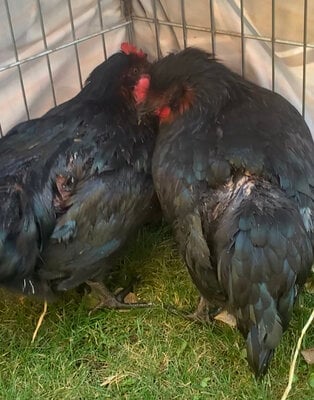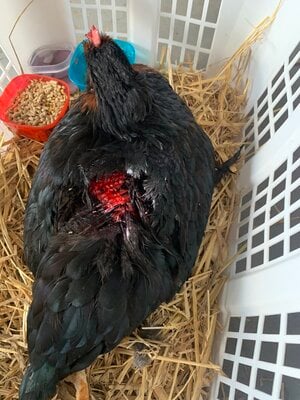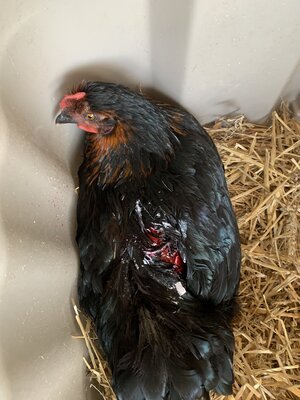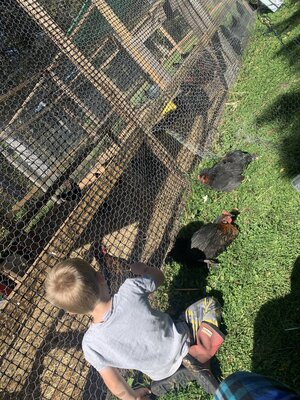Navigation
Install the app
How to install the app on iOS
Follow along with the video below to see how to install our site as a web app on your home screen.
Note: This feature may not be available in some browsers.
More options
You are using an out of date browser. It may not display this or other websites correctly.
You should upgrade or use an alternative browser.
You should upgrade or use an alternative browser.
Blu Kote vs Red Kote
- Thread starter JoMWy
- Start date
Chickens are attracted to blood, and the color red. If you're trying to coat a wound, you'd want to go with the Blue Kote. It masks the color of the blood thus not being so attractive to pecking by others.
There's one thing that puzzles me, and maybe someone here can answer it. I know that chickens are attracted to the color red, and I have seen the proof of this. My question is, why don't they peck at each other's wattles, ear lobes, and combs?
What if I am going to separate the chicken while she heals, which product then and why, please? I recently had a major emergency with one of my pullets and chose Red Kote, it worked beautifullyChickens are attracted to blood, and the color red. If you're trying to coat a wound, you'd want to go with the Blue Kote. It masks the color of the blood thus not being so attractive to pecking by others.

I just used Red Kote on my 5 month old hen as no store near me had blu Kote but she is separated from the others till she heals. Did your chicken heal okay using the red? All went well?What if I am going to separate the chicken while she heals, which product then and why, please? I recently had a major emergency with one of my pullets and chose Red Kote, it worked beautifully
I just used Red Kote on my 5 month old hen as no store near me had blu Kote but she is separated from the others till she heals. Did your chicken heal okay using the red? All went well?
Welcome to BYC @Lorigerl . What's going on with your bird? I suspect there is an injury(?), could you start your own thread, and include a few pictures of the wound?
I wouldn't use Red-kote for several reasons, one being the red color will attract the other chickens to the wound, also you'll be dyeing the wound and it'll be hard to monitor how the healing development is going, and lastly, Red-kote contains isopropyl alcohol which can sometimes be damaging to the god flora on wounds.
They do peck at wattles and combs usually the top of the pecking order does the pecking. Some chickens that get pecked in these areas have black spots... this is the dried blood.There's one thing that puzzles me, and maybe someone here can answer it. I know that chickens are attracted to the color red, and I have seen the proof of this. My question is, why don't they peck at each other's wattles, ear lobes, and combs?
I completely agree about the red-kote!Welcome to BYC @Lorigerl . What's going on with your bird? I suspect there is an injury(?), could you start your own thread, and include a few pictures of the wound?
I wouldn't use Red-kote for several reasons, one being the red color will attract the other chickens to the wound, also you'll be dyeing the wound and it'll be hard to monitor how the healing development is going, and lastly, Red-kote contains isopropyl alcohol which can sometimes be damaging to the god flora on wounds.
Depending on the injury, I use vetericyn to help it heal better and blu-kote if the chicken is able to stay with the flock.
Thank you so much for answering me! I did post my own thread but maybe cause I am new no one is getting back to me, I’ve only had one reply. I’ve attached a couple pictures, I’m so sad this is devastating and I’m trying my best. I live in the middle of no where and the closest place only had red kote I’m going to make a trip tomorrow to get blue Kote. It’s not blood it’s red kote so please don’t be alarmed when looking at the pictures.Welcome to BYC @Lorigerl . What's going on with your bird? I suspect there is an injury(?), could you start your own thread, and include a few pictures of the wound?
I wouldn't use Red-kote for several reasons, one being the red color will attract the other chickens to the wound, also you'll be dyeing the wound and it'll be hard to monitor how the healing development is going, and lastly, Red-kote contains isopropyl alcohol which can sometimes be damaging to the god flora on wounds.
Attachments
Sorry, no one has responded to your thread!
I can't see the wound from the pictures, and the Red-kote doesn't help the matter. Just an estimate, what diameter would you say the wound is, and is the wound shallow, or fairly deep?
I personally would avoid Blue and Red kote, IMO, they both are terrible products to be used on wounds, I've yet to see any vet recommend them. I would try flushing the red kote off with saline, and either applying Vetericyn, or an antibacterial ointment like Neosporin, or Preparation H.
I can't see the wound from the pictures, and the Red-kote doesn't help the matter. Just an estimate, what diameter would you say the wound is, and is the wound shallow, or fairly deep?
I personally would avoid Blue and Red kote, IMO, they both are terrible products to be used on wounds, I've yet to see any vet recommend them. I would try flushing the red kote off with saline, and either applying Vetericyn, or an antibacterial ointment like Neosporin, or Preparation H.
New posts New threads Active threads
-
Latest threads
-
Lookinf for advice on convering this to a chicken coop
- Started by Chicks-A-Hoy
- Replies: 0
-
-
Chicken laid two halves of an egg
- Started by BravoCluckhouse
- Replies: 0
-
-
-
-
Threads with more replies in the last 15 days
-
-
Two dead chicks in brooder pen
- Started by redinator
- Replies: 69
-
Question of the Day - Thursday, August 14th, 2025
- Started by casportpony
- Replies: 69
-
-
Ended BYC Poultry Caption Contest 08-08-25 Pic by Molpet
- Started by TwoCrows
- Replies: 61
-
×









